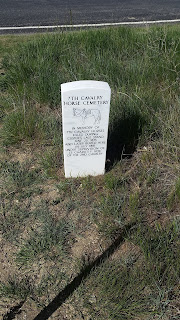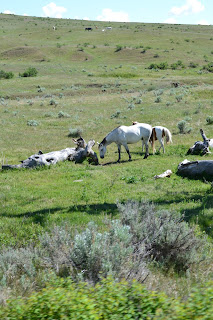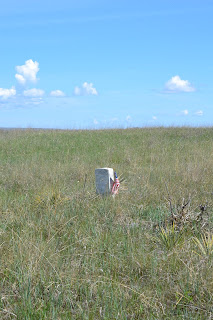 |
| Native American's love Star Wars. I got no less than 5 compliments on my shirt. You can NEVER go wrong with Star Wars. |
So I am going to keep this post short because it has been a really long couple days and I am super tired.
So this was a couple days ago now (the 26th) on our drive from Sheridan (where there is no Sheraton, a real lost opportunity IMO) WY to Yellowstone WY. Along the way we stopped at the Little Bighorn.
WELL going there actually taught me a lot about it. Link to Wikipedia.
So before I share some pictures or make a lot of jokes I want to clarify some points in history.
SKIP THIS IF YOU DON'T WANT A HISTORY LESSON
 |
| Fury Road had nothing appropriate here. |
2- He was ordered to scout out the Rosebud, Bighorn, Little Bighorn by an ACTUAL General, and departed from a far larger column with a full regiment, NOT a single Battalion. This was 12 companies of nearly 600 mounted soldiers.
3- This column was one of three columns in the region searching for the large Indian presence in the region, all of whom were off their reservations. One column had been repelled on the 17th of June at the Battle of Rosebud (not a My Little Pony), where as the Little Bighorn was on the 25th and 26th.
4- WHAT! The battle was 2 DAYS!?!?!?! How is that possible, they all died on the first right? Wrong. The battle was actually two separate battlefields, Last Stand Hill and the Reno-Benteen battlefield. The last stand happened on the 25th, with a single Battalion under Custer's direct command consisting of 5 companies. However a little over half the Regiment, in two battalions of 3 companies each, was under siege about 5 miles east until the morning of the 26th (the 12th company joined these men, they had been escorting the baggage train with ammo and provisions). Majority of them survived as the Indians retreated when the rest of the column Custer's regiment had been a part of drew close to the battlefield.
5- Custer was not looking for a fight. He only started an attack when he and his Officers believed they had been spotted. He did this for multiple reasons; fear of loosing the initiative, fear of the tribes scattering to the four winds (there were 26 tribes of varying nations) and the army not being able to capture them all in one place, and underestimation of the warrior presence and a reliance of them panicking as he attacked the Indian encampment (there were 1500-2000 warriors present, but an estimated 6000 noncombatants in women and children). He also knew the main column was supposed to converge on that position the next day and sent a messenger back to it letting them know where the camp was and asking for reinforcements.
6- Custer ordered Maj. Reno and his men (3 companies) to attack the encampment from the position they were at, sent for Capt. Benteen (3 companies) to join them QUICK. He was to take 5 companies and ride around an attack the camp from the rear. Unfortunately, the Indians did not panic and were in a larger force than anticipated.
7- Reno had to retreat from the Indian camp back to where Custer had ordered the attack from, but was fortunately reinforced by Benteen and the wagon train. As well, they had a defensible position with a steep ravine being the only approach. With all the ammo from the wagon train and 7 companies, they were able to hold out. Meanwhile, when Custer's attack was repulsed further upriver, he was forced further away from Reno and continually lost men during a lengthy retreat, along which he had likely hoped to see Benteen coming to reinforce him, rather than Reno. Eventually, he got to what is known as Last Stand Hill, where he and his remaining men killed their horses to form barricades until they were over ran. On the other side of the battlefield, Reno and Benteen didn't know where their CO was and sent a company to try and find them. Unfortunately, they could not advance far and turned around. However at that point, Custer was likely already dead.
8- Only the 268 men directly under Custer were massacred and later the rest of the regiment discovered his "lost" companies.
9- Later that summer, nearly all the Natives surrendered or returned to their reservations.
SUMMARY-
It wasn't so much one man blinded with delusions of grandeur going up against impossible odds, but more so an aggressive and accomplished commander following orders and advancing with little intelligence and getting sucked into a bad situation.
SO this was probably one of my favourite stops, since I could ACTUALLY SEE History in the as it happened.
 |
| THE INDIANS HAD OVER 5000!!!! |
 |
| Last stand hill. |
 |
| View of the Little Bighorn and where the Indian encampment was from Last Stand Hill. |
 |
| The marker for where they eventually buried the horses Custer's command killed to form barricades. |
 |
| Other side of last stand hill, |
 |
| LOOK AT THOMAS!!! |
 |
| This is the Native American memorial at the site. It used to be "Custer National Battlefield" but political correctness for once got it right. |
 |
| Where Reno attacked from and retreated back to. The markers are of where 3 of Custer's Indian Scouts fell. In all, 53 men fell retreating to this position. |
 |
| The ground he had to retreat over. |
 |
| Where Custer attacked from. |
 |
| You can see the trail of markers leading up to Last Stand Hill. |
 |
| The retreat up the hill. |
We drove onto Yellowstone from there. This involves driving into Montana and then BACK to Wyoming. And then we had to go through miles of construction to get to our camp.










No comments:
Post a Comment